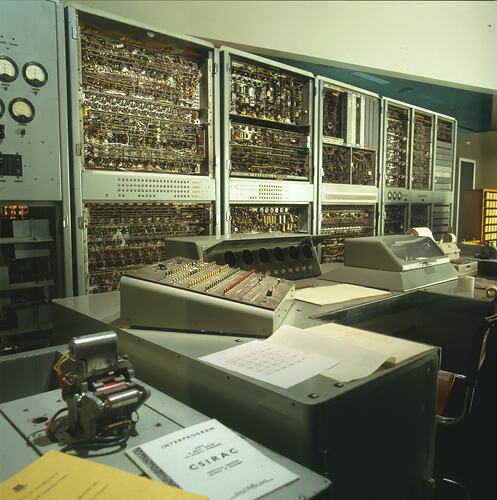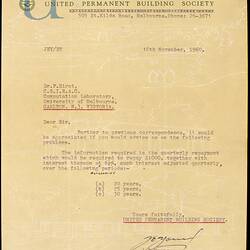HERCUS, ERIC OSWALD (1891-1962), physicist, was born on 23 June 1891 at Dunedin, New Zealand, third son of Scottish-born parents George Robertson Hercus, accountant, and his wife Elizabeth, née Elder. Eric attended Otago Boys' High School, Dunedin, and in his final year (1908) won a senior national scholarship.
In 1909 he entered the University of Otago (B.Sc., N.Z., 1912; M.Sc., 1913) where he obtained first-class honours in almost every subject, and senior scholarships in both mathematics and physics. His Master's degree was awarded the Cook prize and first-class honours. Supported by a government research scholarship, in 1913 Hercus transferred to Victoria (University) College, Wellington, to work under Professor T. H. Laby. This was New Zealand's only university with an active research programme in physics. Laby's passion was precision measurement, and he set Hercus the difficult task of determining the absolute thermal conductivity of air. The work was successfully completed in 1914, though not published until four years later.
Awarded the 1851 Exhibition science research scholarship for New Zealand, Hercus sailed to England and entered Trinity College, Cambridge, in October 1914. He began work in the Cavendish Laboratory under J. J. (Sir Joseph) Thomson on a project on positive rays. Six months later he was appointed a radiography instructor in the Royal Army Medical Corps and sent to Malta. On 21 September 1916 he was commissioned lieutenant, Royal Naval Volunteer Reserve. Posted as scientific adviser on the staff of the flag officer, Dover Patrol, he designed direction-finders for shore-batteries and kept watch in the 'war room' at Dover. He was demobilized on 13 January 1919.
Hercus returned to Cambridge and his work on positive rays. He stayed for only six months before leaving to take up a lectureship at the University of Melbourne, where Laby had held the chair of natural philosophy since 1915. The work in Cambridge came to nothing, but in Melbourne he resumed his collaboration with Laby in a classic redetermination of the mechanical equivalent of heat. The university awarded him a D.Sc. (1928) for his precision measurements in relation to heat. Once this work was completed, his research atrophied and he published only a couple of short and fairly inconsequential papers thereafter.
On 29 January 1924 Hercus married, with Presbyterian forms, his second cousin Florence Hercus, a pianist, in her father's home at Christchurch, New Zealand. Promoted senior lecturer (1923) and associate professor (1931), Eric Hercus served as acting-professor when Laby and his successor (Sir) Leslie Martin were on leave. He taught a wide range of topics, chiefly to upper-level students; his lectures, delivered in the softest of voices, were models of clarity. Those on thermodynamics and statistical mechanics eventually gave rise to a useful textbook, Elements of Thermodynamics (1947), which was expanded and republished as Elements of Thermodynamics and Statistical Mechanics (1951). A tall, spare and retiring man, he willingly shared his knowledge of his subject with those who penetrated his shy exterior.
During World War II Hercus, like his colleagues, took on additional duties. While maintaining his normal teaching responsibilities, he was a member (1940-45) of the Optical Munitions Panel and he participated in work done in his department on the design and manufacture of optical equipment for the armed forces. Later in the war he also lectured on radar to military personnel.
Hercus joined the Institute of Physics (London) in 1923, becoming a fellow in 1929, and took part in the pioneering series of conferences sponsored by the institute's Australian members before World War II. Vice-president (1945) of the institute's Australian branch, he was honorary secretary (1952-55) at a time when the branch was evolving towards becoming the Australian Institute of Physics. He was elected a fellow of the Australian and New Zealand Association for the Advancement of Science and thus a member of the Australian National Research Council in 1946 (joint honorary secretary 1949-50). At the 1951 meeting of the International Union of Physics, held in Copenhagen, he represented Australia.
In 1947-56 Hercus served as his university's representative on the council of the (Royal) Melbourne Technical College, and was president in 1952. He continued to lecture for several years after his retirement in 1956, and acted as a consulting programmer for the early-generation electronic computer, CSIRAC, located at the university. Survived by his wife and son, who was also a physicist, he died suddenly of coronary vascular disease on 30 June 1962 at his Sandringham home and was cremated.
Select References:
R. Bacon, The Dover Patrol, 1915-1917 (London, 1919)
University of Melbourne Magazine, 13, 1919, p. 106
University of Melbourne Gazette, April 1957, p. 12, Sept 1962, p. 9
Hercus papers (University of Melbourne Archives)
Hercus file (Archives of the Royal Commission for the Exhibition of 1851, Imperial College of Science and Technology, London)
Australian National Research Council papers (National Library of Australia).
R. W. Home, 'Hercus, Eric Oswald (1891 - 1962)', Australian Dictionary of Biography, Volume 14, Melbourne University Press, 1996, pp. 439-440. Text copied from http://adbonline.anu.edu.au/biogs/A140506b.htm
More Information
-
Keywords
-
Authors
-
Contributors
-
Article types


